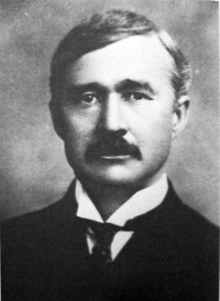Born Oct. 14, 1857, in Portland, Ind. Elwood Haynes was educated in the Jay County public schools. He obtained admission to the Worcester County Free Institute of Industrial Science in Worcester, Mass., in 1873 and graduated from that institution three years later. For his senior thesis he analyzed tungsten’s effect upon iron and steel–an idea he used later in inventing Stellite, an extremely hard, heat-and-corrosion-resistant tool metal.
After graduation, Haynes returned to Portland to teach. He eventually became principal of Portland High School, but left to conduct postgraduate work in chemistry, biology and German at Johns Hopkins University in Baltimore.
With the discovery of natural gas near Portland in 1886, Haynes left teaching and became superintendent for the Portland Natural Gas and Oil Company. In 1890 he was appointed field superintendent for the Indiana Natural Gas Company of Chicago, which had its headquarters in Greentown, Ind. While working for that firm, Haynes’s inventive mind came up with a method to prevent pipelines from freezing by dehydrating the gas prior to its being pumped through the lines. During a lull in his duties in 1891, Haynes began preparing plans and drawings for a new method of travel–a horseless carriage. Moving to Kokomo in 1892 as manager of the gas plant there, he continued to work on his idea. In November 1893 he purchased a one-cylinder, one-horsepower gasoline engine and, a few months later, hired Elmer and Edgar Apperson for 40 cents an hour to construct the vehicle. It was ready for its first test run on July 4, 1894. The car was towed by a horse and buggy (to avoid frightening horses on the busy Kokomo streets) out into the countryside on the Pumpkinvine Pike. With Haynes at the controls, the car traveled about six miles at a speed approaching six or seven miles per hour–becoming one of the first cars in the country to achieve such a feat. With this success behind them, Haynes and the Apperson brothers formed a partnership to design and build the Haynes-Apperson automobiles. Back then, the Haynes touring car was sold for about $3,000. Both Haynes and Apperson Brothers automobiles were built in Kokomo until the 1920s.
In 1910 Haynes donated his Pioneer auto to the Smithsonian Institution in Washington, where it is on permanent display. Previously on display in Reno, Nevada, a 1910 Haynes Model 19 can be found in Portland’s Community Resource Center. Haynes died on April 13, 1925. The Kokomo inventor, if not the first, was among the first Americans to build and drive a gasoline-powered, self-propelled vehicle. He is still remembered today as a brilliant metallurgist and a pioneer in Indiana’s automobile industry.




